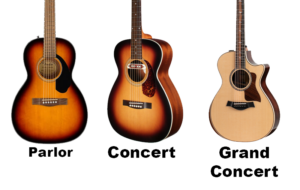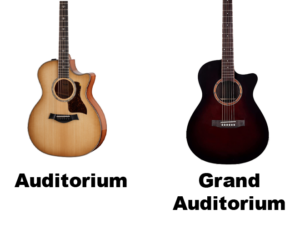Uncategorized
Unlocking the Melodies: A Guide to Lap Steel Tuning
Venturing into the world of lap steel guitar playing is like embarking on a journey through a landscape of soulful melodies and resonant harmonies. At the heart of this captivating musical realm lies a crucial element – lap steel tuning. Tuning a lap steel guitar is a fundamental skill that sets the stage for creating beautiful and evocative music. In this article, we’ll delve into the art of lap steel tuning, offering step-by-step instructions and practical tips to ensure you navigate this essential aspect of lap steel playing with confidence. Get ready to unlock the secrets of lap steel tuning and immerse yourself in the enchanting world of slide guitar!
Introducing Lap Steel Tuning
Before we dive into the specifics of lap steel tuning, let’s take a moment to understand its significance. Lap steel tuning refers to the process of adjusting the strings on a lap steel guitar to specific pitches. Unlike standard guitar tuning, which typically involves tuning to specific notes across the fretboard, lap steel tuning often involves open tunings that create rich and resonant chord structures when the strings are played open (without pressing them down).
Step-by-Step Guide: Lap Steel Tuning
Follow these steps to master the art of lap steel tuning:
1. Choose Your Tuning: Lap steel guitars can be tuned to a variety of tunings, each producing its unique sound and character. Some popular lap steel tunings include Open D (D-A-D-F#-A-D), Open G (D-G-D-G-B-D), and C6 (C-E-G-A-C-E). Choose a tuning that suits your musical preferences and the style you want to play.
2. Use a Tuner: Start by using a tuner to ensure accuracy in your tuning process. Attach the tuner to your lap steel guitar or use a reliable tuner app.
3. Tune the High Strings: Begin by tuning the highest-pitched strings first. For example, in Open D tuning, tune the highest string (closest to your face when playing) to D. Use the tuner to adjust the tension of the string until it registers the correct pitch.
4. Tune the Middle Strings: Move on to tuning the middle strings. In Open D tuning, the next string should be tuned to A, followed by the third string to D. Again, use the tuner to achieve the desired pitches.
5. Tune the Low Strings: Finally, tune the lowest-pitched strings. In Open D tuning, the fourth string should be tuned to F#, the fifth string to A, and the sixth string to D.
Benefits of Lap Steel Tuning
Mastering lap steel tuning offers several benefits for lap steel guitarists:
1. Unique Harmonic Palette: Different lap steel tunings create unique chord voicings and harmonies, allowing you to explore a diverse range of musical textures and moods.
2. Slide Techniques: Lap steel tuning enhances slide guitar techniques, enabling you to glide smoothly across the strings and create emotive slides and bends.
3. Open Chord Possibilities: Open tunings on a lap steel guitar facilitate the creation of open chords by simply strumming the strings without pressing them down. This opens up creative possibilities for chord progressions and melodies.
Practical Tips for Lap Steel Tuning
Here are some practical tips to help you excel in lap steel tuning:
1. String Gauges: Experiment with different string gauges to find the ones that suit your chosen tuning and playing style. Heavier gauges can provide more tension for lower tunings, while lighter gauges are suitable for higher tunings.
2. Tuning Stability: After tuning, gently stretch the strings by pulling on them away from the fretboard. This helps to stabilize the tuning and reduces the likelihood of strings going out of tune during playing.
3. Ear Training: Practice tuning by ear to develop your musical ear and improve your ability to fine-tune your lap steel guitar to the desired pitches.
Famous Songs Featuring Lap Steel Tuning
Lap steel tuning contributes to the signature sound of numerous famous songs across genres. Here are a few examples:
1. “Sleep Walk” by Santo & Johnny: This instrumental classic features the lap steel guitar’s dreamy tones and showcases its emotive capabilities.
2. “Honky Tonk Women” by The Rolling Stones: The lap steel guitar adds a touch of twang and character to the iconic riff of this rock and roll hit.
3. “The Weight” by The Band: The lap steel guitar’s warm and resonant tones contribute to the Americana feel of this timeless song.
Conclusion: Your Musical Odyssey Begins!
Congratulations, you’ve unlocked the art of lap steel tuning! By mastering this fundamental skill, you’ve opened the door to a world of expressive melodies, soulful slides, and captivating harmonies. Whether you’re exploring the haunting beauty of Open D tuning or the vibrant colors of Open G, lap steel tuning empowers you to create music that resonates with depth and emotion.
As you continue your lap steel guitar journey, remember that practice and dedication are key to mastering any aspect of playing. Embrace the joy of learning, celebrate your progress, and let your passion for music guide you forward. With consistent effort and a love for exploration, you’ll find yourself gliding effortlessly across the strings, creating captivating melodies, and expressing your unique musical voice.
Lap steel tuning is just the beginning of your musical adventure. As you delve deeper into the world of lap steel guitar, you’ll encounter a myriad of techniques, styles, and musical concepts that will enrich your playing and allow you to paint your musical canvas with a variety of colors. So, keep tuning, keep exploring, and most importantly, keep enjoying the wonderful journey of creating music with your lap steel guitar. Happy sliding!
Uncategorized
Acoustic Guitar Sizes: Finding Your Perfect Fit
Have you ever wondered how the size of an acoustic guitar affects its sound? From the intimate, focused tones of a parlor guitar to the deep, resonant sound of a jumbo, the size and shape of an acoustic guitar can have a profound impact on its sonic characteristics.”
In this article, we’ll explore acoustic guitar sizes, their variations, and how to choose the perfect size that suits your needs.
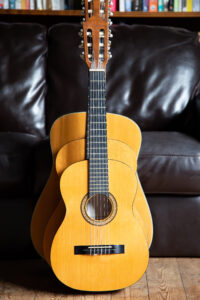 Understanding Acoustic Guitar Sizes: A Musical Puzzle
Understanding Acoustic Guitar Sizes: A Musical Puzzle
Acoustic guitar sizes refer to the dimensions and proportions of the guitar body, which significantly influence the instrument’s tonal characteristics, projection, and playability.
Just like pieces of a musical puzzle, different sizes create distinct voices that cater to various playing styles and preferences.
The Spectrum of Acoustic Guitar Sizes
Acoustic guitars come in several sizes, each with its unique qualities and attributes. Let’s explore some common acoustic guitar sizes and their defining features:
-
-
Parlor Guitar: The parlor guitar is petite and charming, making it an ideal companion for intimate settings.
The name comes from the rooms in which the guitar was typically played in the late 19th century.
Some famous musicians who have been known to use the parlor guitar are, Eric Clapton, Mark Orton, Ed Sheehan, and John Mayer
Its smaller size results in a focused and balanced sound, perfect for fingerpicking and folk music.
-
Concert Guitar: Slightly larger than the parlor guitar, the concert guitar offers enhanced projection and volume. It strikes a balance between portability and sound, making it versatile for various genres.
It is often used in classical music and flamenco music with its full sound.
-
Grand Concert Guitar: With a larger body than the concert guitar, the grand concert guitar boasts a fuller sound and improved tonal complexity.
A popular choice for those who have a smaller stature and require an instrument that’s built to a shorter scale. Great choice for traveling musicians who often play live performances.
It’s suitable for fingerstyle playing and intricate arrangements.
-
Auditorium Guitar: The auditorium guitar, also known as the orchestra model (OM), features a well-rounded sound with a pronounced midrange.
More shallower than the dreadnought and narrower in width than a concert guitar. An Auditorium guitar brings the body closer to the player, making it feel more intimate and comfortable for stage use.
Some famous musicians who play it include Ed Sheeran, John Mayer, and Eric Clapton.
-
Grand Auditorium Guitar: Expanding on the auditorium guitar’s design, the grand auditorium guitar offers a versatile sound profile with enhanced bass response and overall volume.
It is a versatile mid-sized guitar that is a good choice for those who want a single guitar to travel with. The tone is great for strumming and picking. It performs well on stage and in the studio.
It suits a wide range of musical genres.
-
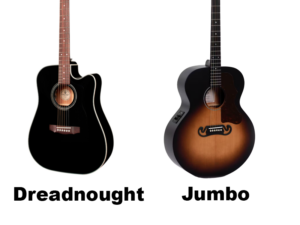 Dreadnought Guitar: The Dreadnought is a true icon, known for its bold and powerful sound. Its large body produces a strong bass response, making it ideal for strumming and vocal accompaniment.
Dreadnought Guitar: The Dreadnought is a true icon, known for its bold and powerful sound. Its large body produces a strong bass response, making it ideal for strumming and vocal accompaniment.This guitar is known for its powerful voice and lower-mid-rich tones that make it a favored choice for country artists. Although it is a popular choice for musicians of all genres.
Some famous musicians who play the dreadnought guitar include Hank Williams Jr, Elvis Presley, Keith Richards, Thom Yorke, and Kurt Cobain.
The original dreadnought guitars were made for the Oliver Ditson Company and featured mahogany backs and sides and spruce tops.
-
Jumbo Guitar: The jumbo guitar lives up to its name with a massive body that delivers robust volume and a deep bass presence.
This is the largest of the guitar family with a deeper body than the popular dreadnought. The body is wider and deeper than traditional acoustic guitars, which gives them a unique appearance.
Jumbo’s are well suited to rhythm guitarists in country and folk rock, and produce a deep rich sound favored by heavy strummers. Some famous musicians who play this guitar are Elvis Presley, George Harrison of the Beatles, Neil Young, Sheryl Crow, and Pete Townshend of The Who.
Choosing the Right Acoustic Guitar Size for You
Selecting the right acoustic guitar size involves considering factors such as playing style, comfort, and tonal preferences. Here are some steps to guide you on your quest:
-
Identify Your Playing Style: Determine whether you lean towards fingerpicking, strumming, or a mix of both. Different sizes excel in different playing styles, so choose one that complements your technique.
-
Consider Body Comfort: Hold and play guitars of various sizes to assess comfort. A guitar that fits well against your body ensures a pleasant playing experience, especially during extended sessions.
-
Evaluate Sound Preferences: Listen to the sound produced by different acoustic guitar sizes. Pay attention to tonal qualities, such as warmth, brightness, and projection, to find the one that resonates with your musical taste.
The Influence of Acoustic Guitar Sizes on Music
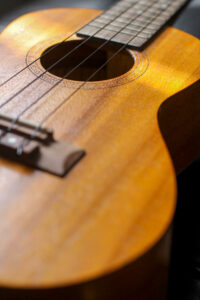 Acoustic guitar sizes and shapes can have a significant impact on the sound of the instrument.
Acoustic guitar sizes and shapes can have a significant impact on the sound of the instrument.The size of the guitar body type also relates to the volume of air within the instrument. Changes to the air capacity of the body will emphasize specific frequencies. A smaller body will have a more focused sound centered on higher frequencies, while a larger body will produce deeper low-end frequencies.
Body dimensions can provide some indication of the tone you might expect, but other factors exert a profound influence, too. Much depends on the tonewoods used to construct the body and the shape, size, and layout of the braces.
Finding Harmony in Acoustic Guitar Sizes
By delving into the nuances of size, sound, and playability, you’ve gained insights that will guide you toward the perfect fit for your musical aspirations.
As you continue your exploration, remember that each acoustic guitar size has its own unique voice and character. Embrace the joy of trying different sizes, celebrate the nuances of their sounds, and let your heart lead you to the one that resonates with your musical soul.
-
Uncategorized
Unlocking the Musical Doorway: Exploring Guitar Keys
Hello, fellow music explorers and curious minds! Have you ever wondered about the magical world of guitar keys and how they shape the melodies we love? Today, we’re embarking on a melodious journey that unravels the mysteries of guitar keys – the secret codes that open doors to harmonies, emotions, and musical expression. Whether you’re a budding guitarist eager to understand the foundations of music or a music enthusiast intrigued by the enchanting sounds of the guitar, this guide will introduce you to the captivating universe of “Guitar Keys.” So, sit back, relax, and let’s embark on a harmonic adventure that will illuminate the way melodies come to life!
Understanding Guitar Keys: The Musical Palette
Imagine a key as a palette of colors that an artist uses to paint a masterpiece. In the realm of music, guitar keys are similar – they provide a set of notes that create a distinct tonal center for a song. Each key has its unique mood, character, and emotional resonance, much like different colors evoke varied feelings in a painting. Just as artists choose their colors intentionally, musicians select guitar keys purposefully to evoke emotions and tell musical stories.
The Basics of Guitar Keys: Major and Minor
Guitar keys come in two primary flavors: major and minor. The major key evokes a bright, uplifting, and joyful feeling, while the minor key carries a more somber, introspective, and melancholic quality. Imagine a major key as a sunny day, and a minor key as a moonlit night – both beautiful, yet conveying distinct emotions.
Key Signatures and Chords: The Building Blocks
A key signature is like a musical roadmap, indicating which notes are natural, sharp, or flat within a particular key. Each key has its unique combination of notes, forming a pattern that dictates the chords and melodies that fit harmoniously within it. For example, the key of C major consists of the notes C, D, E, F, G, A, and B. These notes serve as the building blocks for chords and melodies that create a cohesive musical experience.
Transposing: Shifting the Musical Landscape
Imagine taking a piece of art and placing it in a different frame – transposing is a bit like that for music. Transposing involves moving a song or a melody from one key to another. This can alter the mood and character of the music while maintaining the same structural relationships between the notes. Transposing allows musicians to adapt a piece to suit their vocal range, instrument, or artistic interpretation.
Modulation: Changing the Musical Direction
Modulation is like a musical journey from one key to another. It involves smoothly transitioning from one key to a related key, often to create a sense of progression or development in a composition. Modulation can evoke emotions ranging from anticipation to resolution, adding depth and complexity to a musical piece.
Guitar Keys in Action: Musical Examples
Let’s explore a couple of musical examples to illustrate the impact of guitar keys:
1. “Happy” by Pharrell Williams: This upbeat song is in the key of F major, which contributes to its joyful and celebratory vibe.
2. “Eleanor Rigby” by The Beatles: The melancholic atmosphere of this classic is attributed to its key of E minor, enhancing its introspective and emotional lyrics.
Conclusion: Embrace the Harmonic Adventure
Congratulations, you’ve embarked on a harmonious adventure through the captivating realm of guitar keys. As you explore major and minor tonalities, key signatures, and the art of transposing, you’ll gain a deeper appreciation for the role keys play in shaping the melodies and emotions that resonate within us. Whether you’re strumming chords on an acoustic guitar or shredding solos on an electric, the world of “Guitar Keys” offers a treasure trove of possibilities waiting to be unlocked. So, the next time you hear a song that moves your soul, remember that it’s the result of a careful selection of notes and chords – a musical key that opens the door to a world of harmonies, emotions, and infinite creativity.
Uncategorized
Harmonious Reflection: Embracing Easy Worship Songs on Guitar
In the world of music, there exists a serene space where melodies intertwine with spirituality, creating a harmonious sanctuary for both the musician and the listener. For those who wield the strings of a guitar, this space is illuminated by easy worship songs—a collection of melodies that carry messages of faith, hope, and devotion. Whether you’re a beginner strumming your first chords or an experienced player seeking moments of introspection, easy worship songs on guitar offer a gateway to a meditative and soul-stirring musical journey. In this article, we’ll embark on a melodious exploration of some of these songs, celebrating their simplicity and the spiritual solace they bring.
Simplicity in Harmony
Easy worship songs are characterized by their simplicity—both in terms of chord progressions and lyrical content. These songs are designed to be accessible to players of all skill levels, making them an ideal starting point for beginners who wish to combine their love for music with their spiritual journey.
1. Amazing Grace
“Amazing Grace” stands as a timeless anthem of redemption and grace. With its straightforward chord progression and a melody that gently guides the listener, this song is a perfect introduction to playing worship music on the guitar. As you strum the chords, you’ll not only create music but also evoke a sense of divine presence.
2. What a Beautiful Name
The song “What a Beautiful Name” resonates with themes of adoration and reverence. Its uncomplicated chord structure, combined with heartfelt lyrics, makes it a wonderful choice for those looking to express their faith through music.
3. Blessed Be Your Name
“Blessed Be Your Name” offers a soothing and reflective melody that speaks of gratitude in both times of abundance and trial. Its chord progression is approachable for beginners, while its message is universal and comforting.
4. Here I Am to Worship
“Here I Am to Worship” captures the essence of humility and offering. The song’s simplicity in chords and melody creates a space for introspection, allowing you to connect deeply with the lyrics and find solace in your worship.
5. Oceans (Where Feet May Fail)
“Oceans” invites listeners on a journey of trust and surrender. While its chord changes may present a slight challenge for beginners, the emotional depth of the song and its resonant message make it a rewarding choice for those willing to venture a bit further.
A Spiritual Journey Through Sound
When you strum the chords of easy worship songs on guitar, you’re not just playing music—you’re creating a bridge between the earthly and the divine. Each note you pluck resonates with a message of hope, comfort, and connection, transcending the boundaries of mere sound.
The Joy of Collective Worship
Easy worship songs also find their home within congregations, where a group of individuals comes together to offer their voices in collective worship. Playing these songs on the guitar allows you to contribute to this harmonious symphony of faith, inviting others to join in and share in the spiritual experience.
A Guiding Light for Beginners
For those just beginning their guitar journey, easy worship songs serve as a guiding light. They provide an opportunity to practice basic chord transitions, strumming patterns, and finger placement while engaging in a meaningful and uplifting musical activity.
A Journey of Spirit and Sound
In the embrace of easy worship songs on guitar, you embark on a journey that transcends music alone. You create an intimate connection between your soul, your instrument, and the divine. As you strum and sing, you’re not just producing melodies—you’re weaving a tapestry of faith, hope, and devotion that resonates in the hearts of both the player and the listener. So, whether you’re a beginner seeking to learn your first chords or an experienced guitarist seeking moments of spiritual reflection, easy worship songs on guitar offer a sacred space where sound and spirit intertwine in perfect harmony.
-
advanced9 years ago
How to Play “Sleepwalk” on the 3-String Guitar! Guitar TABs Included!
-
beginner8 years ago
3-String or 4-String? How to Decide Which is Right for You!
-
beginner9 months ago
Exploring Different Guitar Types: A Beginner’s Guide
-
Blues Guitar8 years ago
Go-To Tunings for Blues Slide Guitar
-
advanced9 months ago
Fun and Effective Guitar Exercises: Elevate Your Playing with These 5 Simple Techniques
-
Uncategorized9 months ago
Acoustic Guitar Sizes: Finding Your Perfect Fit
-
Blues Guitar7 years ago
Jack Daniel’s Whiskey Barrel Guitar: How It’s Made and What it Sounds Like
-
Guitars9 months ago
Bass vs Guitar: Exploring the Musical Journey

